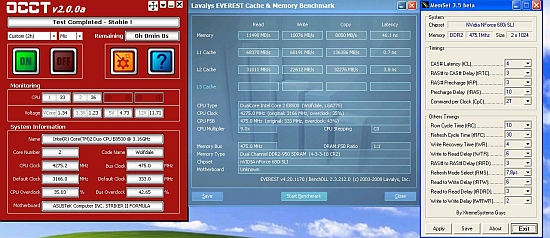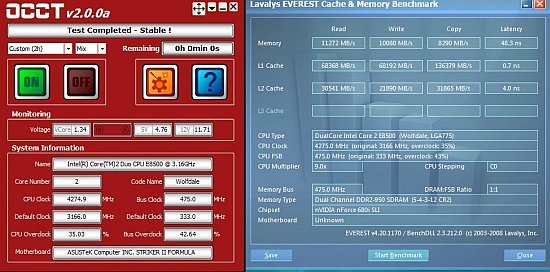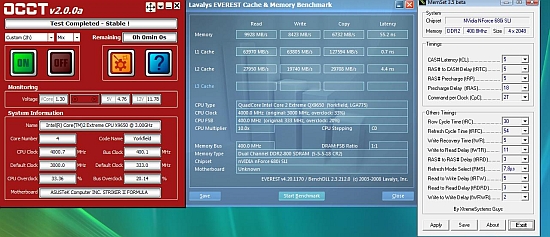ASUS Striker II Formula under the Microscope
by Rajinder Gill on March 19, 2008 4:00 AM EST- Posted in
- Motherboards
"Stable" Dual-core and Quad-core Overclocking Results
E8500 on Windows XP SP3 with Cell Shock's 2x1GB Kit
 |
For dual-core processors running the XP operating system, the interesting zone is certainly around 475FSB running in sync mode. Don't be fooled by the memory speed at 950Mhz; remember 1:1 mode allows the most efficient form of data transfer via the MCH. For the Cell Shock modules - which use Micron's top D9GKX DDR2 bin - these speeds are a breeze. What's more, the speed comes at a voltage that the board and modules can easily operate at on a 24/7 basis.
We found that more than 2.15V on our modules was not necessary to hold these speeds 100% stable. The modules are certainly capable of a lot more, but it is nearly impossible to achieve it within warranty specifications. Of course YMMV (Your Mileage May Vary), but in general, if you have good DDR2 modules that are aggressively binned, this is the sweet-spot for operation on this board. We tested with a VMCH (Northbridge Voltage) at a mere 1.3V on our board to hold this setting steady. For us, this represents the greatest level of performance return per watt of energy expenditure.
E8500 with 8GB of OCZ's finest on Vista 64-bit
 |
This was the shocker for us, using 8GB of OCZ memory with a dual-core E8500. The modules only required 1.95V to hold this speed, while VMCH was at 1.4V - both respectable. The read speeds are higher than we have managed on any Intel chipset using 8GB of memory. Sure, this is not mainstream yet, but we think that testing with 8GB offers an opportunity to check a board's stability much more than 2GB configurations. We have seen lower access latency on earlier Striker II BIOS releases; however, the stability was not there at these voltages. Things are a bit more sensible now and the board passed everything we threw at it - including multiple Crysis and PCMark Vantage test runs over the course of the last two weeks. Now the question is what happens when we replace the dual-core with a quad-core processor.
QX9650, 8GB, and Vista 64-bit equals trouble
This is where things enter the twilight zone. Finding stability at higher FSBs with quad-core CPUs can be quite a challenge on the 680i/780i chipset. On the back of our 8GB memory overclocking success using the E8500, we decided to go straight for the jugular and use 8GB of memory with the QX9650. Let's start with what we thought would be a stable configuration.
 |
Although the transition in processors and configurations seems small when you look at the screenshots on the page, it does not show how long it took us to acquire this screenshot. Our initial attempts were all made by trying to dial in all the memory timings ourselves. Eventually we realized that tWTR needs to be very loose when using the QX9650 and set manually to 11 at the minimum. After repeated attempts, we let the board set the rest of the secondary timings via memory SPD. We stumbled across OCCT's base test with a pass, but Crysis failed in its first loop. PCMark Vantage also threw a "fit" when the 3D Gaming test began. We tried everything we could to get 3D stability but no amount of memory timing adjustments or component voltages brought us to the promised land of 3D stability.
The next step was to lower CPU multipliers and reduce CPU speed in order to coax a little more overhead from the Northbridge. Again we failed, all the way down to 3.2GHz when using 1600QFSB (400FSB). As the QX9650 has the advantage of an unlocked multiplier, we decided to use the 10x multi and a lower FSB speed. We even went down to using a 4GB configuration with the 2X2GB modules and found the same overall FSB wall. In the end we found that 3.5GHz with an FSB of 1400QFSB (350MHz) was the highest we could achieve and still pass PCMark Vantage. It seems that FSBs in the region of 400MHz have marginal stability with the quad-core processors when stressed with actual application benchmarks. We ran out of time to test with a 2GB configuration but will include this in part two when we take a close look at the abilities of EVGA's 780i board once we coax it back to life.










18 Comments
View All Comments
joex444 - Wednesday, March 19, 2008 - link
"1500QFSB (350MHz)" 2nd to last page, last paragraph.Do you mean 1400QFSB or (375MHz)?
Rajinder Gill - Wednesday, March 19, 2008 - link
Sorry, 1400 is what it should read - corrected now..Thanks
Raja
Beenthere - Wednesday, March 19, 2008 - link
Asus continues to produce half-baked CRAP for motherboards. They have been doing this for the past five years and people still buy their defective crap. When are consumers going to learn that a company will sell crap until people stop buying it and demand properly functioning products? People who are foolish enough to buy these defective products deserve exactly what they get.Margalus - Thursday, March 20, 2008 - link
sounds like someoone is bitter because they didn't buy an Asus board and thinks nobody else should have a decent motherboard because of that. Asus makes very good, stable motherboards.. Better than most. I don't know a single person that has had a problem with Asus. I am currently using this Striker Formula because I wanted sli and an e8400. The thing is typical Asus. Quality from the ground up, and not a single problem with it, as usual.takumsawsherman - Wednesday, March 19, 2008 - link
There's no point to this board anyway. $340 and you still don't get Firewire800? Even if it does work properly and doesn't fail prematurely, it's overpriced for any benefit you could possibly derive from using such a board.skinflickBOB - Thursday, March 20, 2008 - link
If there were REAL demand for Firewire 800 on a board like this, it would probably be here. If it's such a big concern, have you thought about writing the big guns direct? I doubt anyone other than an old fart like me is really listening. Looking back at the review section (god it's been a long time since I last did), all I see is this comment about Firewire 800. Such a burning desire for an 'extra' should surely be chased down to where it matters.. But then, you would never buy a board for $300, so what's the issue?. I don't go down to the nearest Lamborghini garage and complain about the Murciélago using a 6.5 litre engine or being a low ride or whatever, cos I ain't buying the SOB. If it's such a big deal, buy yourself one of those budget 650i boards and spend the rest on a top notch Firewire card. there you go - job done.. Is that hard or something to think of?booyakasha..
Bazoo - Wednesday, March 19, 2008 - link
As a previous owner (and unhappy one) of striker extreme, I would say that's a total waste of money. I heard lot's of reports of 650 and 750 based motherboards being much better overclockers and still capable of sli for much less money. It seems the little brothers are not that buggy like the 680/780 and would be interesting if anandtech dwelve in to that. In any event, only time would restore (or not...) my confidence in nvidia chipsets, even the 790 one (could be a joy in the sky) but... I would take a wait and see attitude. Then again, with intel changing socket in 9 months, I rather will sticky with my trust and fas p35 mb.Lord 666 - Wednesday, March 19, 2008 - link
While I agree with you on the defective piece as the only MB that has ever died on me is an ASUS, you are a little off base with your pointless rant.Only with the 790's is the price getting a little out of hand, but MB's aren't that expensive so you can just buy another one.